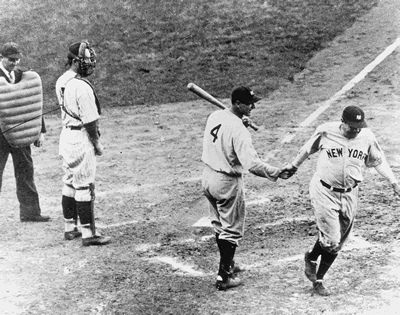By Sean Evans (The Cascade) – Email
Print Edition: June 20, 2012
The fact that many people associate the name Lou Gehrig with a disease rather than a baseball player is sad given his skill as an athlete. There is much more to Lou Gehrig than the disease that ultimately took his life on June 2, 1941.
Gehrig was born on June 19, 1903, in New York City. His father, Heinrich, and his mother, Christina, emigrated from Germany and struggled to find work in North America, the land of opportunity. Christina often did laundry, house cleaning and cooking to help the struggling Gehrig family get by, as Heinrich was unemployed and had poor health. From these humble beginnings, Lou managed to get a football scholarship at Columbia University, where he began to study engineering in 1921.
Although football was his sport, a friend advised Gehrig that money could be made playing professional baseball during the summer. As this was a violation of collegiate sports rules, Gehrig played under the name Henry Louis. When he was eventually caught, he was banned from playing football for Columbia during his freshman year.
That was no problem, however, as Gehrig was hooked on baseball. In 1923, while playing for the Columbia baseball team, pro-ball scout Paul Krichell discovered the talented novice pitcher and hitter. Gehrig’s natural abilities and stellar batting average landed him a contract with the New York Yankees in 1923, complete with a $1,500 signing bonus. That amount adjusts to over $20,000 by today’s dollar; a hefty total given professional sports standards at the time. Gehrig joined the Yankees roster in 1925, and played on first base for the next 13 years.
Gehrig soon earned the nickname “Iron Horse,” as he often played through injuries: a broken thumb, broken toe and back spasms to name a few. Lougehrig.com states that near the end of his career, x-rays showed “17 different fractures that had ‘healed’ while Gehrig continued to play.” Gehrig continued to play through pain and injury for 2130 straight games—a remarkable feat in its own right.
Not only did Gehrig play through thick and thin, he played well. For 12 straight seasons, Gehrig topped .300 (that’s a batting average; it’s a good one). He, along with the legendary Babe Ruth, dominated the MLB for a number of years. After Ruth retired, it was Gehrig and Joe DiMaggio that owned the competition. Given that, one begins to see why the Yankees are the most hated team in baseball – they have a history of signing players with prodigious skill, and were home to all three legends.
Gehrig helped lead the Yankees to six World Series victories, he was an All-Star seven times, American League MVP twice, and team captain from 1935-1939. All in all, Gehrig was much more than just a name for a devastating disease.
In 1938 things started grinding to a halt. Gehrig fell below .300 for the first time in 13 years. His performance wasn’t what it used to be: Gerhig was tired, he lacked strength, and was missing balls that he used to knock out of Yankee Stadium. When he couldn’t run to first base at the beginning of the 1939 season, Gerhig knew that he was finished. On May 2, 1938, as team captain, Gerhig handed in the line up card to the umpire for the final time – without his name on it. The “Iron Horse” streak was over, and Gerhig was just beginning his fight with a disease that he would soon be known for.
Amyotrophic Lateral Sclerosis (ALS) is a rare degenerative disease that, according to Lougehrig.com, “is an incurable fatal neuromuscular disease characterized by progressive muscle weakness, resulting in paralysis. The disease attacks nerve cells in the brain and spinal cord. Motor neurons, which control the movement of voluntary muscles, deteriorate and eventually die. When the motor neurons die, the brain can no longer initiate and control muscle movement. Because muscles no longer receive the messages they need in order to function, they gradually weaken and deteriorate.”
Gehrig would never play baseball again. On July 4, 1939, the 62,000 fans in attendance at Yankee Stadium watched Gehrig as he announced his retirement and gave a speech that would be remembered as one of the most moving moments in sports history. Gehrig called himself the “luckiest man on the face of the earth” and stated: “I might have been given a bad break, but I’ve got an awful lot to live for.”
Gerhig succumbed to the disease on June 2, 1941, and was mourned across the nation.
For more information on ALS and Lou Gerhig, visit lougerhig.com.


